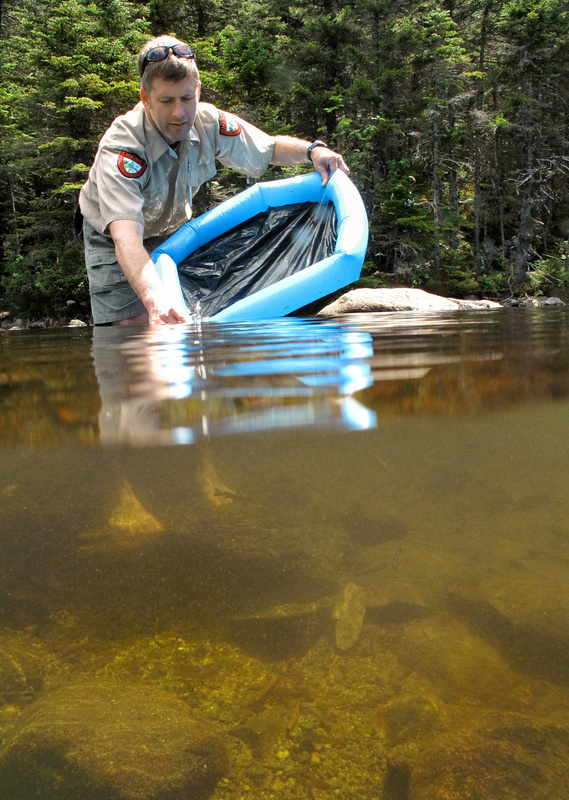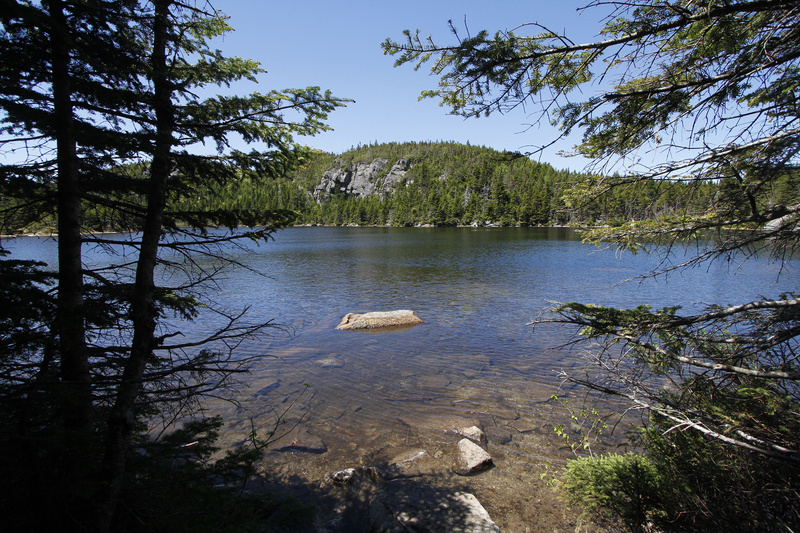WYMAN TOWNSHIP – A two-hour climb and pair of sore legs.
That’s the price for fishing a pristine, cold-water brook trout fishery on top of a mountain. Except intrepid anglers take note: This year’s far-flung ponds might not be so cold.
At The Horns Pond atop Bigelow Mountain state biologists who hiked up to stock the pond two weeks ago found an unlikely scene and new kind of problem.
Greg Bell and Dave Howatt each carried 200 brook trout in water tanks to a pond with a surface water temperature of 67 degrees. Considering most years the biologists happily break ice to release the fussy game fish into this wild western Maine pond, the warmer water was not good for the brookies, which require clean, cold water.
Fortunately for the trout — and fishermen who’ll work to cast to them this summer — Bell anticipated the problem and hiked in with some extra equipment to help the fish acclimate: a blow-up kiddie pool.
He wasn’t about to hike four hours for nothing.
“The first year we carried up coolers. That didn’t work so well,” said Howatt with the Department of Inland Fisheries and Wildlife.
For 25 years state biologists have climbed up to The Horns Pond to offer the more rugged fishermen the thrill of hiking to the quiet, the sweeping views, and relative privacy of a remote fishing hole. It is one of three mountain ponds the state stocks now. Little Tea Pond in Jim Pond Township and Mountain Dimmick Pond in Caratunk are the other two.
These ponds need to be stocked because they lack spawning habitat.
“People like this type of thing. One guy had a canoe stashed in the woods for a while,” Howatt said.
The fish are hatchery-raised, but stocked only a few months after they’re born, so the trout look more wild than the usual hatchery-reared fish. And if the fish don’t fool fishermen, the location at The Horns Pond will with its clear, rocky, out-of-the way shores within the Bigelow Preserve.
“If you saw a fish in here it was a trout, because there is nothing else in here,” Howatt said. “We’ve never seen a wild fish in here. Way, way back, a million years ago there was native fish in here, but they just died off.”
On May 27 the two state biologists spent a full two hours climbing four miles of the Fire Wardens Trail on Bigelow Mountain with their 40-pound backpacks.
These look just like ancient hiking packs but are in fact tanks that hold cold oxygenated water. The sloshing of the water during the uphill hike creates more oxygen, and that’s fine.
“When they get too much oxygen, they go to sleep. It quiets them down,” Howatt said. “They get very lethargic in the cold water.”
But this year, with the unusually warm spring, Bell anticipated a new kind of problem and was ready.
The Gray hatchery the fish traveled from had water that was 52 degrees. The ice water in the packs was further chilled to 38 degrees to help the fish travel better.
Were Bell to put them immediately into 67-degree water, the brook trout would suffer.
They’ve never felt water that warm, he said.
So he blew up his kiddie pool, placed it in the pond and waited 25 minutes as the kiddie pool water slowly warmed to let the trout acclimated to the warmer pond water.
Elsewhere, a 5- to 6-inch brook trout darted through the water waving its tail and lunging near the rocky shore as it fed.
“That would be about the size of last year’s trout,” Howatt said and smiled.
The water in the makeshift holding pool was warmed quicker than Bell liked, but he said the fish showed great life.
When he dumped the floating pool into the pond the 400 trout spread out in groups in several directions. Bell looked up and smiled at Howatt who stood on the shore, watching his annual spring hiking buddy.
“We did it again,” Bell said. “Not a single mortality.”
Staff Writer Deirdre Fleming can be contacted at 791-6452 or at:
dfleming@pressherald.com
Send questions/comments to the editors.





Comments are no longer available on this story